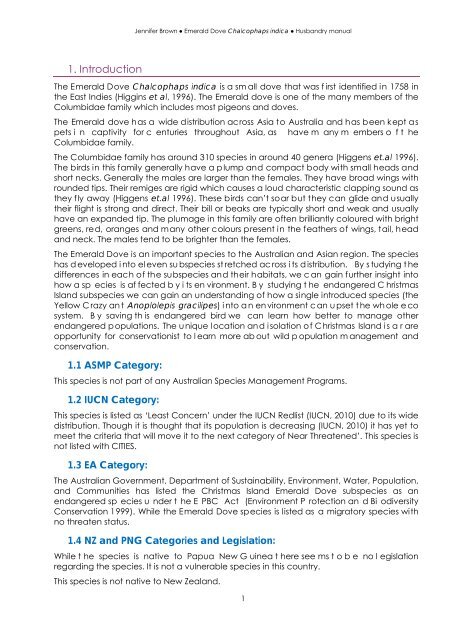Emerald Dove Husbandry Manual - Nswfmpa.org
Emerald Dove Husbandry Manual - Nswfmpa.org
Emerald Dove Husbandry Manual - Nswfmpa.org
Create successful ePaper yourself
Turn your PDF publications into a flip-book with our unique Google optimized e-Paper software.
Jennifer Brown ● <strong>Emerald</strong> <strong>Dove</strong> Chalcophaps indica ● <strong>Husbandry</strong> manual<br />
1. Introduction<br />
The <strong>Emerald</strong> <strong>Dove</strong> Chalcophaps indica is a sm all dove that was f irst identified in 1758 in<br />
the East Indies (Higgins et al, 1996). The <strong>Emerald</strong> dove is one of the many members of the<br />
Columbidae family which includes most pigeons and doves.<br />
The <strong>Emerald</strong> dove has a wide distribution across Asia to Australia and has been kept as<br />
pets i n captivity for c enturies throughout Asia, as have m any m embers o f t he<br />
Columbidae family.<br />
The Columbidae family has around 310 species in around 40 genera (Higgens et.al 1996).<br />
The birds in this family generally have a p lump and compact body with small heads and<br />
short necks. Generally the males are larger than the females. They have broad wings with<br />
rounded tips. Their remiges are rigid which causes a loud characteristic clapping sound as<br />
they fly away (Higgens et.al 1996). These birds can’t soar but they can glide and usually<br />
their flight is strong and direct. Their bill or beaks are typically short and weak and usually<br />
have an expanded tip. The plumage in this family are often brilliantly coloured with bright<br />
greens, red, oranges and many other colours present in the feathers of wings, tail, head<br />
and neck. The males tend to be brighter than the females.<br />
The <strong>Emerald</strong> <strong>Dove</strong> is an important species to the Australian and Asian region. The species<br />
has d eveloped i nto el even su bspecies st retched ac ross i ts d istribution. By s tudying t he<br />
differences in each of the subspecies and their habitats, we c an gain further insight into<br />
how a sp ecies is af fected b y i ts en vironment. B y studying t he endangered C hristmas<br />
Island subspecies we can gain an understanding of how a single introduced species (the<br />
Yellow C razy an t Anoplolepis gracilipes) i nto a n en vironment c an u pset t he wh ole e co<br />
system. B y saving th is endangered bird we can learn how better to manage other<br />
endangered populations. The u nique location and i solation of Christmas Island i s a r are<br />
opportunity for conservationist to l earn more ab out wild p opulation m anagement and<br />
conservation.<br />
1.1 ASMP Category:<br />
This species is not part of any Australian Species Management Programs.<br />
1.2 IUCN Category:<br />
This species is listed as ‘Least Concern’ under the IUCN Redlist (IUCN, 2010) due to its wide<br />
distribution. Though it is thought that its population is decreasing (IUCN, 2010) it has yet to<br />
meet the criteria that will move it to the next category of Near Threatened’. This species is<br />
not listed with CITIES.<br />
1.3 EA Category:<br />
The Australian Government, Department of Sustainability, Environment, Water, Population,<br />
and Communities has listed the Christmas Island <strong>Emerald</strong> <strong>Dove</strong> subspecies as an<br />
endangered sp ecies u nder t he E PBC Act (Environment P rotection an d Bi odiversity<br />
Conservation 1999). While the <strong>Emerald</strong> <strong>Dove</strong> species is listed as a migratory species with<br />
no threaten status.<br />
1.4 NZ and PNG Categories and Legislation:<br />
While t he species is native to Papua New G uinea t here see ms t o b e no l egislation<br />
regarding the species. It is not a vulnerable species in this country.<br />
This species is not native to New Zealand.<br />
1

















